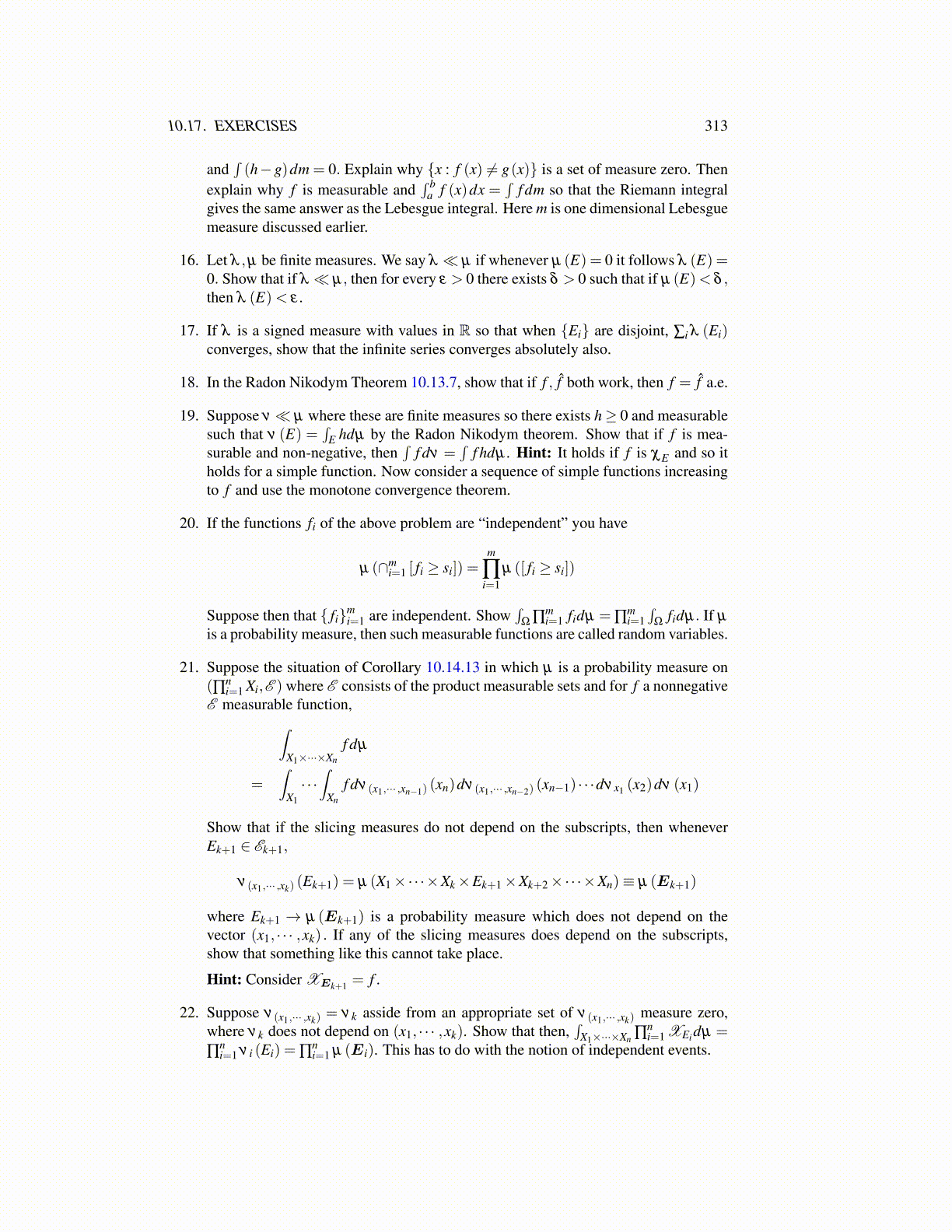
10.17. EXERCISES 313
and∫(h−g)dm = 0. Explain why {x : f (x) ̸= g(x)} is a set of measure zero. Then
explain why f is measurable and∫ b
a f (x)dx =∫
f dm so that the Riemann integralgives the same answer as the Lebesgue integral. Here m is one dimensional Lebesguemeasure discussed earlier.
16. Let λ ,µ be finite measures. We say λ ≪ µ if whenever µ (E) = 0 it follows λ (E) =0. Show that if λ ≪ µ, then for every ε > 0 there exists δ > 0 such that if µ (E)< δ ,then λ (E)< ε .
17. If λ is a signed measure with values in R so that when {Ei} are disjoint, ∑i λ (Ei)converges, show that the infinite series converges absolutely also.
18. In the Radon Nikodym Theorem 10.13.7, show that if f , f̂ both work, then f = f̂ a.e.
19. Suppose ν≪ µ where these are finite measures so there exists h≥ 0 and measurablesuch that ν (E) =
∫E hdµ by the Radon Nikodym theorem. Show that if f is mea-
surable and non-negative, then∫
f dν =∫
f hdµ . Hint: It holds if f is χE and so itholds for a simple function. Now consider a sequence of simple functions increasingto f and use the monotone convergence theorem.
20. If the functions fi of the above problem are “independent” you have
µ (∩mi=1 [ fi ≥ si]) =
m
∏i=1
µ ([ fi ≥ si])
Suppose then that { fi}mi=1 are independent. Show
∫Ω ∏
mi=1 fidµ = ∏
mi=1∫
Ωfidµ. If µ
is a probability measure, then such measurable functions are called random variables.
21. Suppose the situation of Corollary 10.14.13 in which µ is a probability measure on(∏n
i=1 Xi,E ) where E consists of the product measurable sets and for f a nonnegativeE measurable function,∫
X1×···×Xn
f dµ
=∫
X1
· · ·∫
Xn
f dν(x1,··· ,xn−1) (xn)dν(x1,··· ,xn−2) (xn−1) · · ·dνx1 (x2)dν (x1)
Show that if the slicing measures do not depend on the subscripts, then wheneverEk+1 ∈ Ek+1,
ν(x1,··· ,xk) (Ek+1) = µ (X1×·· ·×Xk×Ek+1×Xk+2×·· ·×Xn)≡ µ (Ek+1)
where Ek+1 → µ (Ek+1) is a probability measure which does not depend on thevector (x1, · · · ,xk) . If any of the slicing measures does depend on the subscripts,show that something like this cannot take place.
Hint: Consider XEk+1 = f .
22. Suppose ν(x1,··· ,xk) = νk asside from an appropriate set of ν(x1,··· ,xk) measure zero,where νk does not depend on (x1, · · · ,xk). Show that then,
∫X1×···×Xn ∏
ni=1 XEidµ =
∏ni=1 ν i (Ei) = ∏
ni=1 µ (Ei). This has to do with the notion of independent events.